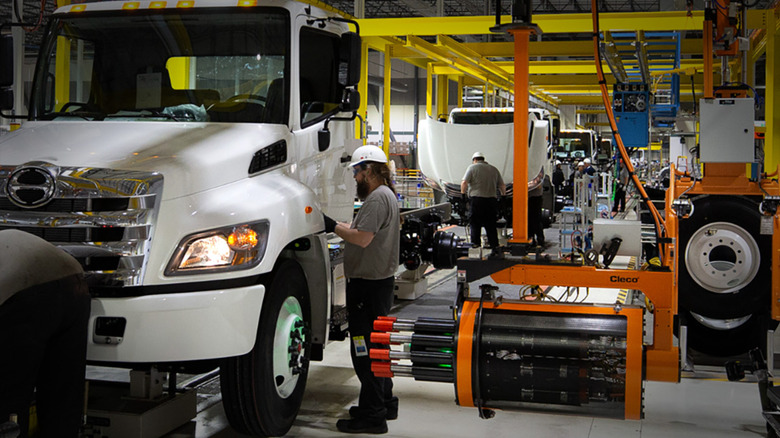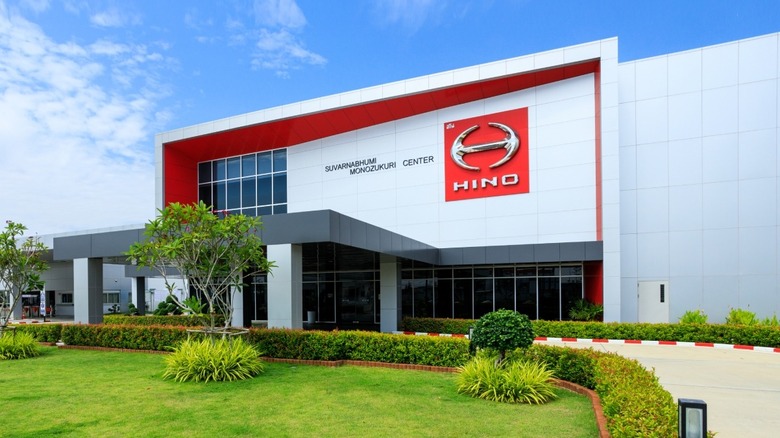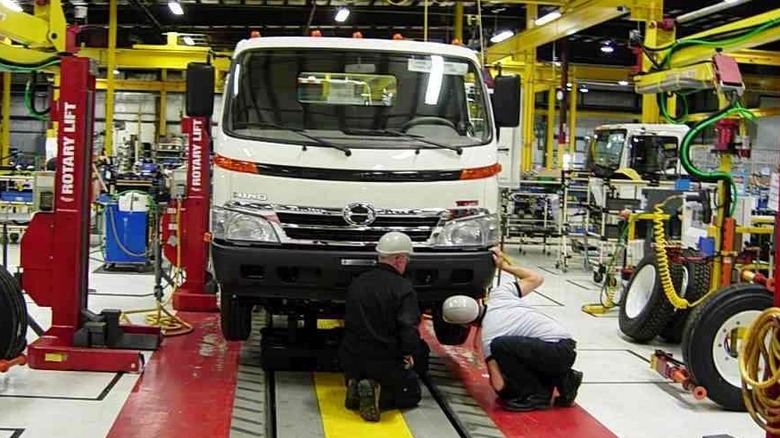Who Makes Hino Trucks And Where Are They Built?
Driving on U.S. roads, it's not uncommon to see trucks from Peterbilt, Kenworth, and Freightliner. After all, they're known for their American roots, readily available parts and support, and extensive dealer network — they're pretty much the most accessible brands to companies and trucking services. In recent years, though, you've probably encountered one other truck brand on the road too: Hino.
Hino is among the Japanese auto manufacturers still using diesel engines. The company first entered the U.S. market in 1984 with the FF175 truck, and to better accommodate the demand, it started its parts operations in 1995. While the company isn't as prominent as the other American trucks, it's slowly growing and even pushed out its 50,000th vehicle after only nine years of local production.
Hino was founded and has its headquarters in Tokyo, Japan, but its products are available in many countries besides the U.S. Here's a quick look at who makes Hino trucks and where the vehicles are built.
Who makes Hino trucks?
Hino trucks are made by the Japan-based Hino Motors company, a subsidiary of another Japanese firm, the Toyota Group. This makes Hino one of the auto brands that are actually owned by Toyota, but before Toyota became the company's majority shareholder in 2001, Hino started as its own enterprise.
It was initially called Tokyo Gas Industry Company in 1910, but later became Tokyo Gas and Electric Industry (TG&E). Although named as such, the company was mostly known as a manufacturer of vehicles that were fully designed locally. These included the Model TGE A-Type Truck in 1917, and the T10 and T20 Model Trailer Trucks in 1946. It wasn't until 1942 that TG&E adopted the name Hino Heavy Industry Co., which was heavily inspired by Hino City where its headquarters are stationed.
More than two decades later, in 1966, Toyota and Hino Motors went into a cooperative alliance. Toyota taught Hino its manufacturing techniques, and Hino was commissioned to build Toyota's Publica Van and later, the Toyota HILUX. This business venture led to Hino's gradual rise as a truck manufacturer. In fact, by 1974, the company was already the leading medium and heavy duty truck supplier in Japan. Toyota eventually invested in the company, acquiring 50.1% of its stocks, to make it part of the Toyota Group.
Where are Hino trucks built?
Hino trucks are made at various Hino Motors production facilities scattered across the globe. In Japan alone, there are four plants located in Hino and Hamura in the Tokyo Metropolis, Ota in Gunma Prefecture, and Koga in Ibaraki Prefecture. Hino Motors also has two proving grounds in the country, where their trucks undergo testing. These are found in Ibaraki Prefecture and Hokkaido Prefecture.
To serve the North American market, Hino Motors established two sites in the U.S. and one in Canada. The one-million-square-feet factory in Mineral Wells, West Virginia is dedicated to truck manufacturing alone, pushing out Class 6 and 7 medium duty trucks and some specialized trucks. The other U.S. facility in Marion, Arkansas makes frame side rails for the medium duty trucks, and engine connecting rods for Hino's diesel engines. Meanwhile, in Woodstock, Ontario, the site is responsible for medium and heavy duty truck assembly, particularly those with Cummins L9 and B6.7 engines — yes, Hino is one of those semi-trucks with Cummins engines.
If talking about size, the Thailand location, specifically the recently opened Suvarnabhumi Plant, takes the spot for being among the biggest Hino overseas manufacturing facilities. It covers over 4.3 million square feet and is where the Hino trucks and buses in Thailand are produced. The country's three other plants — Bangpakong, Bangplee, and Samrong — are mainly for fabricating auto parts.
Hino trucks are built in a host of other Asian, Middle East, and Central/South American countries too. You can find production sites in Indonesia, Malaysia, Vietnam, the Philippines, Pakistan, Colombia, and Mexico.


